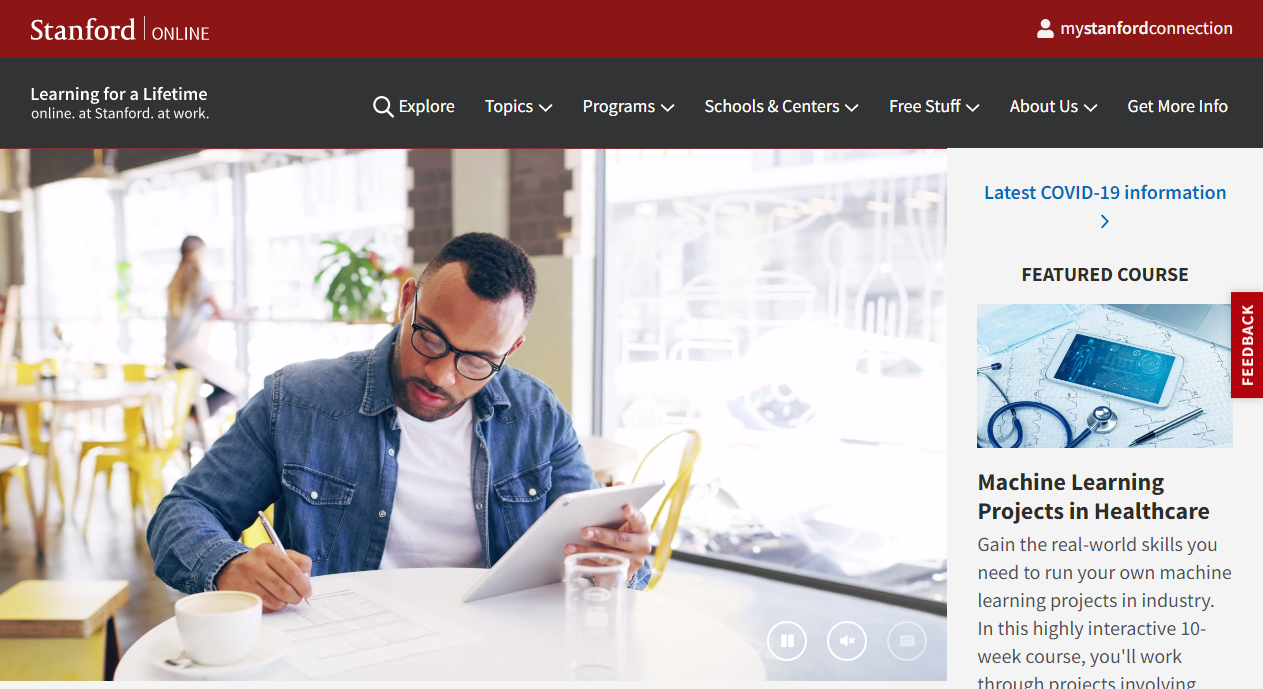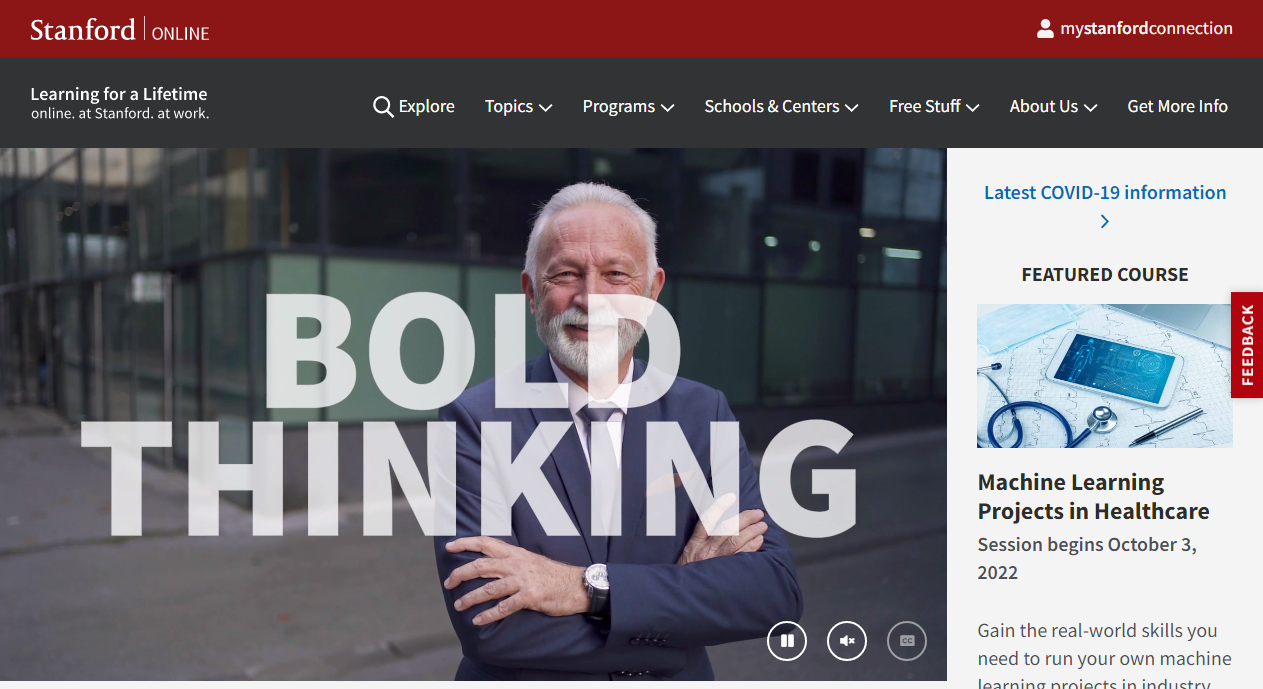Free Online Courses at Stanford
One of the most prestigious institutes of higher learning in the world is Stanford University. It is known as a center of excellence around the world, and its degrees are very valuable. Free Online Courses at Stanford serve as a method to share its cutting-edge academic research and creative concepts with a wider audience.
As of October 2022, Stanford University has teamed up with Coursera and edX to offer more than 96 free online courses on a variety of subjects, including health and medicine, education, the arts and humanities, engineering, and more. You can choose from free content, professional education, credit-bearing programs, and graduate degrees.
Stanford University is a major voice around the globe and has one of the most outstanding lists of graduates, breakthroughs, and inventions. Taking a free online course at Stanford will not only boost your CV it can also redefine your career path.
Continue reading to learn more about free online courses at Stanford.
Free Online Courses at Stanford
Many people have always wanted to attend Stanford University, but many are unable to do so due to expense, distance, or other constraints. These individuals can now complete their education, or at least a portion of it, thanks to the Free Online Courses at Stanford.
Find the list of free online courses at Stanford below:
- Business & Management
- Computer Science
- Cybersecurity
- Data Science
- Education
- Design Thinking & Creativity
- Energy & Sustainability
- Engineering
- Health & Medicine
- Humanities & Sciences (8)
Business & Management
The Principles of Economics course is among the most fascinating ones offered by the Business and Management department. This 10-week course’s first half focuses on microeconomic analysis, including how consumers and businesses behave. You’ll examine markets for goods and services as well as the impact of policy decisions on these markets.
Macroeconomic ideas including national production, employment, inflation, and interest rates are covered in the course’s latter sections. You’ll study the models used to predict the long-term expansion and short-term fluctuations of national economies. The function of governmental regulation, monetary policy, and fiscal policy will next be covered.
Computer Science
Algorithms: Design and Analysis, Part I course. You will discover a number of important foundational ideas of algorithm design in this course. The divide-and-conquer design paradigm will be covered, with examples of how it can be used for quick sorting, searching, and multiplication. You’ll discover a number of lightning-quick primitives for graph computation, including how to compute connectivity and the shortest pathways. Last, you’ll look at how letting the computer “flip coins” can result in sophisticated and useful algorithms and data structures.
Cybersecurity
An essential technique for securing data in computer systems is cryptography. During the Cryptography I course offered by Stanford, the underlying workings of cryptographic primitives and how to effectively employ them are covered. Students will learn how to use their newly acquired knowledge to reason about the security of cryptographic constructs in the real world.
The course starts off by going into great depth about how two people who share a secret key can communicate safely even when a strong adversary listens in and tampers with traffic. You will look at a number of deployed protocols and analyze flaws in current systems.

Public-key strategies that enable two or more participants to generate a shared secret key are covered in the second half of the course. You’ll go over the pertinent number theory, talk about public-key encryption, and go over the fundamentals of key exchange. Students will encounter various fascinating open challenges in the area during the semester.
Data Science
You can study statistical thinking ideas that are necessary for drawing conclusions from data and articulating insights in Stanford’s “Introduction to Statistics.” By the end of the course, you will be able to do exploratory data analysis, comprehend fundamental sampling concepts, and choose suitable tests of significance for various situations. You will acquire the fundamental abilities needed to study more complex statistical reasoning and machine learning courses.
Education
All levels of math students can enroll in the How to Learn Math: For Student course. It combines fresh research on the most efficient methods for approaching and learning mathematics with truly crucial knowledge of the brain and learning. Many people dislike math or do poorly because of bad arithmetic experiences.
This session will provide math students with the knowledge they need to become strong math learners, correct any misconceptions they may have about arithmetic, and teach them about their own potential for success as well as the approaches to math that will work best for them. This will assist in transforming your connection with arithmetic from one that has historically been negative to one that is powerful and positive.
Design Thinking & Creativity
This online course employs a design thinking methodology to assist individuals of all ages and educational backgrounds in developing a positive and successful approach to building their careers. The main focus of this course is five career-oriented vocational wayfinding principles, which are further developed through exercises and personal reflections.
The Stanford Life Design Lab designed a course called Designing Your Career to assist people in designing their lives and jobs.
Energy & Sustainability
If you are into Energy and sustainability then the first online course in the world for mapping deforestation and forest degradation is called Forest Monitoring with CLASlite. The goal of this course is to provide the knowledge required for using the Carnegie Landsat Analysis System-lite, or CLASlite, to monitor forests for governmental, academic, and non-profit groups. The course gives other information to facilitate easy forest monitoring utilizing Earth-observing satellite data, as well as the scientific underpinnings for each module in CLASlite.
Engineering
Anyone with a reasonable college-level understanding of physical science or engineering can learn quantum mechanics in the nine-week course Quantum Mechanics for Scientists and Engineers and Quantum Mechanics for Scientists and Engineers 2. Historically, physicists, chemists, and other basic sciences were largely interested in quantum mechanics. Today, many branches of engineering and research, including materials science, nanotechnology, electrical devices, and photonics, depend heavily on the principles and methods of quantum mechanics. This course provides a thorough introduction to quantum physics and its applications. It is specifically made to be accessible to students and technical professionals with a wide range of science and engineering backgrounds in addition to physicists.
Health & Medicine
The course “Neuromuscular Monitoring” might be something you’d enjoy taking if you work in the medical field. You will gain knowledge of how to assemble objective neuromuscular monitoring equipment, perform troubleshooting, analyze objective neuromuscular monitoring measurements, and integrate objective neuromuscular monitoring into your daily practice while also understanding its critical role in lowering the risk of residual neuromuscular blockade. This course will last for one to two weeks.
Humanities & Sciences
The concept of agape love (compassion/kindness) as a force for social justice and action, as the inspiration for service and the application of knowledge to positive social change, will be explored in the course, “Love as a Force for Social Justice.” The discussion of love will include its biological, psychological, theological, and social aspects and will draw on the knowledge of experts from a number of fields.
The following subjects will be brought up and discussed over the six-week course: Love as a fundamental tenet of various religious and ethical beliefs (such as Judaism, Christianity, Islam, Buddhism, and Gandhianism); types of love/definitions of love; non-violent communication; love and the biology of the brain; love expressed in action; and poetic expressions of love as a social force. This curriculum intends to promote an understanding of the significance of love as a fundamental phenomenon in the development of the human community, connection, and functional societies.
Stanford University Free Online Courses
Being an ivy league university, Stanford University is one of the most exclusive universities in the world. It is extremely prominent and is on par with Yale and Harvard. Due to a lack of available spots, thousands of prospective students are rejected every year.
Read Also: Free Online Courses at Harvard
Stanford online
The center for Free Online Courses at Stanford is known as Stanford Online. It is run by the Stanford Development Center and provides extended education on campus in addition to accelerating global access to high-quality online education. This is how Stanford’s contribution to the growth of the international community

Stanford University offers the majority of its online content on its own platform, but it also collaborates with some outside parties to make some of its courses available on other platforms. Several of those platforms consist of;
- Coursera
- edX
- Get smarter
- Great Learning.
This is to ensure that individuals take advantage of technology and the gift of information to get ready for the difficulties unique to this era and keep up with the rapidly expanding body of practical knowledge. Stanford places a particular emphasis on advanced courses.
They offer courses that provide the knowledge required to lead in a competitive environment and make a technological shift. They provide courses in fields where there is insufficient common knowledge to fill the gap.
See Also: Free Online Courses in Canada
Why Take Free Online Courses At Standford?
Many people might be wondering why they should enroll in Free Online Courses at Stanford. The reasons are plain to see. One of the top experts in the world will be providing you with the best instructional audio for free, or more accurately, practically free.
The simplicity of being able to listen in at your convenience and at a pace that works for your schedule. Both your personal development and career advancement may greatly benefit from this. In today’s workplaces, more information is expected of us, and Stanford’s free online courses can fill that gap.
How To Register For Free Online Courses At Stanford?
Through a variety of venues, including Coursera, Stanford University offers free courses. You must download the Coursera app, register, and search for the course you want to take before you may enroll for free. Free Online Courses at Stanford are done on Coursera, and after that, you can begin taking classes at your own pace.
Conclusion
In this post, we addressed the value and usefulness of Stanford’s free online courses in the information economy and how people might benefit from them to improve their life.
